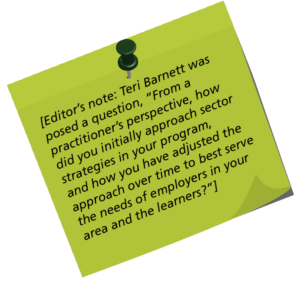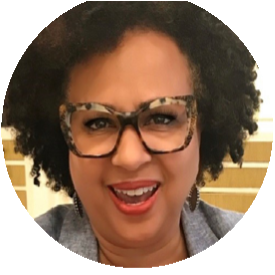Will it Stick?
Developing Adult Education Workforce Strategies
by Teri Barnett

The Beginning
The academic and workforce development needs for adult education learners in Northern Virginia (NOVA) are remarkably different from any other region in the state. Our learners, regardless of the program, are about 95 percent English language learners. They represent a cross-section of skills, careers, economic backgrounds, and education. Last year’s demographics for my program at Alexandria City Public Schools Adult Education Program showed that our students in federally-and state-funded programs were about 85% female, came from 33 different countries, and spoke 70 or more languages. Educationally, 1% had a college education, 8% finished college, and 91% did not complete high school. Career-wise, like across much of Northern Virginia, our students work in demanding low-wage, unskilled jobs such as hospitality, food service, and housekeeping. Often these jobs compete with improving their English or GED® skills due to long work hours and the high cost of living in the Washington D.C. metropolitan area. With this, I have always been mindful of the requirements of the Workforce Innovation Opportunity Act (WIOA) of 2014 and the Adult Education Family and Literacy Act (AEFLA) whenever I generate a new program.
Back in 2013, a gentleman by the name of Aneesh Chopra requested to meet with me to discuss a program called PlugGED In. During our meeting, I could barely focus on the conversation because I was befuddled trying to figure out why the former U.S. and Virginia Secretary of Technology was really in my office talking to me about this program. Little did I know that he was the architect of PluggedInVA, which was initially started with Adult Education Program Manager Linda Allen at Southwest Community College. After researching the program and reaching out to Linda Allen and Kate Daly Rolander (both of whom proved to be excellent mentors), I developed the one-and-only PluggedInVA program in NOVA. Focusing on the medical industry, our students would earn a credential and training to become clinical data medical coders or phlebotomists.
I was elated. I had buy-in from my school district, made flyers, and recruited GED® students. Per Aneesh Chopra’s introduction, I met with Northern Virginia Community College’s (NVCC) Medical Campus provost, who was on board and extremely helpful. He arranged meetings with his administrative team. NVCC arranged for our students to have on-site instructors to teach two for-credit courses. We became eligible training providers through our local Workforce Development Council.
The Transition
Just when I thought we were flying high, we were sidelined. The NVCC administrative team decided we could no longer be a part of the medical campus due to the Southern Association of Colleges and Schools™ Council on Accreditation and School Improvement (SACS CASI) accreditation guidelines. They recommended the workforce side of the community college, which had fewer restrictions. Now, all of our students had to work toward the pharmacy tech credential. This seemed perfect because we now had CVS pharmacy as our industry partner.
Unfortunately, many students lost interest in the pharmacy tech program after earning their GED® credential. It was evident that our scope was limited. Students were interested in the medical field but just not in becoming a pharmacy technician. We had limited options via NVCC’s workforce program, plus they were no longer making their instructors available to us. Our advocate, the Provost, had retired, and we were running solo. After shuttering PluggedInVA, I continued a variety of workforce development career training programs that included partnering with Dominion Power and Goodwill Industries to create a Utility Groundsmen Program, a Commercial Driver’s License (CDL) learners’ permit course, and the ServSafe Level II certification. Our successes were small, with two or three students earning a credential and gaining employment.
Today
With all regions responsible for creating multiple Integrated Education and Training (IET) programs, I have decided on taking a different route. A local hotel is interested in hosting contextualized English classes for their housekeeping staff and we are waiting for the partnership agreement. This summer, I provided a Microsoft Office Suite Word and Excel class and job-readiness training for 12 AEFLA students in partnership with our local One-Stop Employment Resource Center (now known as Virginia Career Works Center). We now offer the Microsoft Office Suite course to the administrative support staff in my school district and to our One-Stop Employment Resource Center. I have come to realize that our students could articulate information learned but transferring that to tests was a challenge. Therefore, it is important to teach academic vocabulary and to include informa-tional text and ELA/CCRS standards in instruction at all levels.
Lessons Learned
1. Study the industry trends in your region.
2. Determine attainable credentials that meet industry trends.
3. Find willing nontraditional partners.
4. Get your staff certified to teach the course.
5. Stay open and network often.
6. Think like a business person.
7. Have a roadmap.
8. Finally, if it doesn’t stick, try and try again.

With close to two decades of experience as an educator, Teri Barnett offers a unique blend of leadership, vision, and knowledge. She holds an MEDL and a professional school administrator’s license. For the past nine years, Teri has lead the Adult Education Program of Alexandria City Public Schools as Coordinator and currently as the Director. Through her leadership, she has created a variety of programs that serve approximately 1,000 adults from over 30 countries annually through English Language Learners, GED®, GED® Corrections, ISAEP, the Adult High School Diploma, and various workforce development programs.